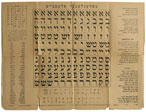Resources

Visit the websites below for more information.
- Omniglot
- Ethnologue – Yiddish Eastern
- Ethnologue – Yiddish Western
- Jewish Language Research
- Jewish Computing
- Academic Jewish Studies Internet Directory
Translators
The Alliance is building a web page to provide information to assist those interested in Yiddish language translation, interpretation, archival work, and education. Learn more.
![]()
This online, searchable database of profiles allows heritage language programs to exchange ideas and resources with one another.

Introduction
Yiddish is a fusion language with Germanic, Hebraic, and Slavic elements and hundreds of thousands of speakers worldwide. The primary language of Ashkenazic Jews, Yiddish is currently spoken mostly in Israel, Russia, the United States, and several European countries. There are over 150,000 speakers of Yiddish in the United States and Canada. Yiddish is more than 1,000 years old (Rourke, 2000), and it started primarily as an oral language. There are two main dialects, Western Yiddish (spoken in Central Europe until the 18th century) and Eastern Yiddish (spoken throughout Eastern Europe and Russia until World War II).
Before World War II and the Holocaust, there were an estimated 11 million speakers of Yiddish, with most Ashkenazi Jews around the world speaking it. Yiddish was usually categorized as a “folk” language, a jargon, to be spoken by ordinary people, especially by women and uneducated men illiterate in the more prestigious Hebrew, German, or Russian. Yiddish is now spoken by Hasidim and a few rapidly shrinking groups of culturally oriented Jews. Yet Yiddish boasts a tremendous body of written and recorded language that will soon be incomprehensible to all but a few.
With most speakers of Yiddish killed in the Holocaust and with Yiddish holding a shrinking role in Israel and the United States, it has largely been relegated to a language of the past and is, therefore, endangered. While many rich resources in Yiddish remain (such as Holocaust memorial books, diaries, memoirs, and correspondence), there are few people who can read this language.
The Alliance for the Advancement of Heritage Languages is seeking to develop knowledge about Yiddish, support development of and resources about the language, and collaborate with other organizations and individuals interested in the Yiddish language.
Adapted from Heritage Voices Language: Yiddish below.
![]() The Alliance for the Advancement of Heritage Languages has developed the Heritage Voices Collection, an online series of documents designed to allow heritage language speakers and programs to share their unique voices with visitors to our website.
The Alliance for the Advancement of Heritage Languages has developed the Heritage Voices Collection, an online series of documents designed to allow heritage language speakers and programs to share their unique voices with visitors to our website.
-
Read about the Yiddish Language.
 (PDF, 452 KB)
(PDF, 452 KB)
Meet the Language Representative
Dr. Miriam Isaacs serves as the Alliance Language Representative for Yiddish. Learn more about Dr. Isaacs or email her.
Return to Heritage Language Spotlights page.
